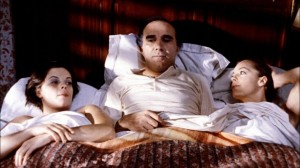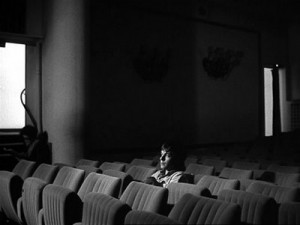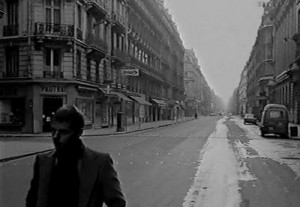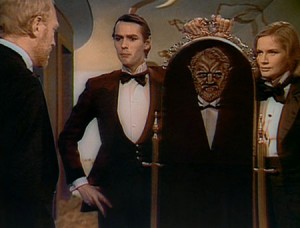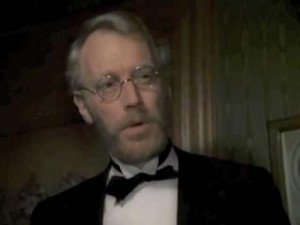From Oui (December 1974). – J.R.
Le Trio lnfernal. It’s the Christmas season and Michel Piccoli shoots
a man in the eye — straight through a newspaper he’s reading — while
downstairs, Romy Schneider is finishing off Andrea Ferreol with
similar dispatch. The bodies are stripped clean and plunked into
adjacent bathtubs, which Piccoli promptly fills with sulfuric acid.
Mascha Gomska, Schneider’s sister — who completes the infernal
trio of murderers who slaughter people for their life insurance –
barfs on the living-room carpet, while offscreen, excited by all
these gay and yummy events, Schneider is giving Piccoli an
impromptu blowjob in the bathroom. Later on, after the bodies have
decomposed, Piccoli dons a gas mask, ladles the slop into pails,
then empties the heady stew outdoors while one of the girls is
shown eating spaghetti. Excessive? This Grand Guignol comedy is
nothing but, as it chronicles the exploits of three glamorous
monsters butchering their way to wealth, with lots of kinky sex
on the way. Francis Girod, a producer-turned-director, exhibits an
unusual amount of expertise in his first film. But most of the show
belongs to Piccoli, who dances through all of the Thirties décor
performing a veritable concerto of comic invention. And for
sound-effects freaks, the bathtub glop is recorded so lovingly as it
gurgles into a pit that you can almost taste it.
-– JONATHAN ROSENBAUM
***
Un Homme Qui Dort. “A man who sleeps,” the title calls
him. For Georges Perec and Bernard Queysanne, the writer
and director who have co-authored this curious film, it’s a
man alone — in Wordsworth’s phrase, A mind forever/
Voyaging through strange seas of thought, alone. Word and
image conspire to create the stream-of-consciousness of a
French student (Jacques Spiesser) who, after taking his final
exams, shuts himself up in his one-room flat and freaks on
himself. What we see are mainly images of Paris outside, and
what we hear — apart from electronic music with voices — is
the voice of a woman rhythmically chanting the thoughts that
pass through his mind. In the beautifully composed black-and
-white photography of Bernard Zitsermann, the whole thing
looks a lot like what the French cinema was offering us ten or
fifteen years ago in films like Hiroshima, Mon Amour and
[Alain Jessua’s] Life Upside Down — long walks down
deserted streets that look like lunar landscapes, sudden
surrealistic flashes (a flaming sink in a junkyard), and stray
objects turned into luminous and unsettling presences. It’s
no surprise that this film copped France’s Jean Vigo Prize
this year, or that director Georges Franju has called it “a
triumph of dreamlike cinema.” The only wonder is how Perec
and Queysanne were able to squeeze so much hypnotic mileage
out of so damn little. -– J.R.
Steppenwolf. We’re in a decadent-looking German night
club in the 1920s where Pierre Clementi, the bandleader,
plays saxophone and sings bouncy tunes to the guests.
Seated at one of the tables are Max von Sydow and Dominique
Sanda. “I don’t know how to dance,” Von Sydow remarks
ruefully. “How triste!” says Sanda sympathetically. Believe it or
not, we’re back in the world of Hermann Hesse’s famous novel.
Fred Haines, who copped an Oscar nomination for the adaptation
of James Joyce’s Ulysses that he co-authored and helped to
produce, has been trying to get this one together for a long time.
He shot most of it in Basel with a cast and crew drawn from a
dozen countries, then got down to perfecting all the complicated
trick photography involved in the Magic Theater sequence — a
central part of the Hesse novel — which utilizes paintings by
Mati Klarwein and a video-electronic-mixing contraption known
as a Blue Box. What comes out of all this heavy labor? Lots of
flash, anyway. If you liked the pious Classics Illustrated job
done on Ulysses, you just might dig this one. It has the same
kind of reverence for the original source and the same sort of
crazy-quilt mixture of mainstream styles. Sanda and Clementi
both seem to have a bit of trouble with their English, but Von
Sydow has his down pat and with his usual mastery gives the
movie whatever continuity it has. But if you want to understand
the story, check out Hesse. — J. R.

